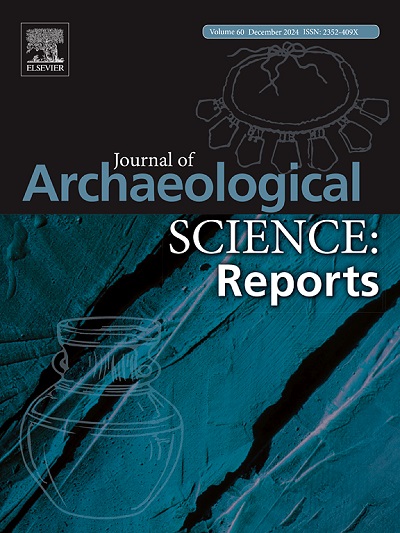全新世晚期上圣克鲁斯河流域(阿根廷巴塔哥尼亚)狩猎采集者的 δ13C 和 δ15N
IF 1.5
2区 历史学
0 ARCHAEOLOGY
引用次数: 0
摘要
本研究旨在考察从圣克鲁斯河上游盆地的两个遗址中发现的个体的古饮食变化,其年代分别为全新世晚期的初期和晚期。文中展示了 14 个个体骨胶原的 δ13C 和 δ15N 值。观察到两种不同的古地层。第一种与摄入陆地巴塔哥尼亚草原资源有关,正如预期的那样,属于较大的样本组。第二种古饮食是在 Río Bote 1 号(RB1-A)的一个成年雄性个体身上观察到的,尽管该个体被发现时距离最近的海岸有 180 公里远,但其饮食中明显含有海洋资源。此外,还考虑了从巴塔哥尼亚南部类似墓葬中发现的人类遗骸的 δ13C 和 δ15N 值。在大的空间分析尺度上,突出了全新世晚期巴塔哥尼亚狩猎采集者饮食的多样性。这反映了群体在流动性和与特定环境相关的食物摄入方面的多样性。然而,所观察到的古饮食范围并不意味着在更大的空间范围内缺乏技术、手工艺品、生态文物和观念的流通。本文章由计算机程序翻译,如有差异,请以英文原文为准。
δ13C and δ15N in hunter-gatherers of the Upper Santa Cruz river basin (Patagonia, Argentina) during the Late Holocene
This study aims to examine the paleodietary variation of individuals recovered from two sites in the upper basin of the Santa Cruz River dated at the beginning and end of the Late Holocene. δ13C and δ15N values from bone collagen of 14 individuals are presented. Two different paleodiets were observed. The first one was associated with the intake of terrestrial Patagonia steppe resources and, as expected, belongs to the larger group of samples. The second paleodiet was observed in a male adult from Río Bote 1 (RB1-A), which, despite being discovered 180 km away from the nearest coast, clearly incorporates marine resources into his diet. In addition, δ13C and δ15N values in human remains recovered from similar burials in southern Patagonia are considered. The diversity of Patagonian hunter-gatherers’ diets during the Late Holocene was highlighted on a large spatial analytical scale. This reflects diversity of groups in terms of mobility and food intake in relation to specific environments. The observed paleodietary circumscription, however, does not imply a lack of circulation of technologies, artifacts, ecofacts, and ideas at wider spatial scales.
求助全文
通过发布文献求助,成功后即可免费获取论文全文。
去求助
来源期刊

Journal of Archaeological Science-Reports
ARCHAEOLOGY-
CiteScore
3.10
自引率
12.50%
发文量
405
期刊介绍:
Journal of Archaeological Science: Reports is aimed at archaeologists and scientists engaged with the application of scientific techniques and methodologies to all areas of archaeology. The journal focuses on the results of the application of scientific methods to archaeological problems and debates. It will provide a forum for reviews and scientific debate of issues in scientific archaeology and their impact in the wider subject. Journal of Archaeological Science: Reports will publish papers of excellent archaeological science, with regional or wider interest. This will include case studies, reviews and short papers where an established scientific technique sheds light on archaeological questions and debates.
 求助内容:
求助内容: 应助结果提醒方式:
应助结果提醒方式:


